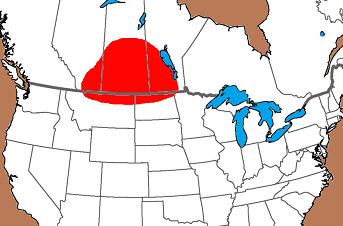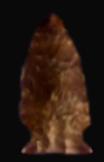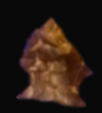Name Details:
Named By: Dyck
and Morlan
Named For:
Date Identified:
1995
Type Site: Sjovold
Site
Outlook
Cluster:
Date:
Cultural Period:
2,500 - 2,400 B.P.
Woodland
Roman Warm
Bracken Phase
Glacial Period:
Culture:
Phase:
Outline is Representative of Size and Shape:
Description of Physical Characteristics and Flaking Pattern:
This is a
broad small to medium triangular side notched point with a flattened to elliptical cross section. The blade may range from excurvate to rarely straight
with the widest portion of the blade being just above the notches. Shallow parallel
U or V notches create a wide neck and shoulders that are most commonly angled upwards, but some examples may be
almost horizontal. The stem is
short and expanding and has rounded
basal corners or ears. The base may vary from straight to very slightly concave with basal
thinning and basal grinding present. This point is manufactured
using random percussion flaking with pressure flaking used to trim and
retouch the blade forming a random flaking pattern.
Size Measurements: Data needed
Distribution:
Distribution Comments:
These points are thought to be early Besant type points primarily found
in Alberta
and Saskatchewan and into Montana and North Dakota.

Additional Comments:
These points are similar in form to the newer
Besant points.
Peck (2011) argues that the Outlook points
represent an early Sonora intrusion into southern Canada in order to
establish trading routes.
Dyck and Morlan (1995) suggest the the Outlook point be a small early form
of the Besant point.
Pictures:


Other points in this Cluster:
Point Validity: Valid Type
Dyck was a distinguished archaeologist who worked as the curator for the
Saskatchewan Museum of Natural History. Morlan was an influential
archaeologist who developed the CARD system. This type was defined in
a professional publication and has many professional references. This
is considered a valid type.
.
Age Details:
Radiocarbon dates of 2,500 +/- 82 at the Sjovold site (Kevinsen,
2013)
Pictures Provided By:
References: (See Reference Page, Entry Number):
199
Coxtanlan Projectile Point, Coxtanlan Arrowhead




